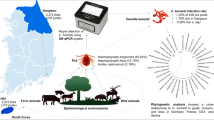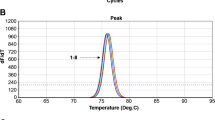Abstract
Ticks are well-known vectors for a wide range of pathogenic microorganisms. We examined the presence of Rickettsia spp., Anaplasma spp., Borrelia spp., Coxiella burnetii and Francisella tularensis in Ixodes ricinus ticks collected in central Slovakia using oligo-chip based assay. Rickettsiae were detected in 5.6% of examined ticks. Borreliae and anaplasmae were identified in 2.1% and 2.8% ticks, respectively. All tested samples were negative for presence of Coxiella burnetii and Francisella tularensis. All these results were compared with those obtained by PCR analysis, and a close correlation between them was found. In addition, rickettsiae of spotted fever group (SFG), Anaplasma phagocytophilum and Borrelia burgdorferi sensu lato were found in ticks using genera or species-specific PCR methods. They are circulating in 10 out of 18 studied localities.
Similar content being viewed by others
Abbreviations
- LB:
-
Lyme borreliosis
- SFG:
-
spotted fever group
- s.l.:
-
sensu lato
- s.s.:
-
sensu stricto
References
Bjöersdorff A., Bagert B., Massung R.F., Gusa A., & Eliasson I. 2002. Isolation and characterization of two European strains of Ehrlichia phagocytophila of equine origin. Clin. Diagn. Lab. Immunol. 9: 341–343.
Blaškovič D. & Barák I. 2005. Oligo-chip based detection of tick-borne bacteria. FEMS Microbiol. Lett. 243: 473–478.
Brezina R., Řeháček J., Áč P. & Majerská M. 1969. Two strains of rickettsiae of Rocky Mountain Spotted Fever group recovered from Dermacentor marginatus ticks in Czechoslovakia. Acta Virol. 13: 142–145.
Černý V. 1972. The tick fauna of Czechoslovakia. Folia Parasitol. 19: 87–92.
Demaerschalck I., Ben Messaoud A., De Kesel M., Hoyois B., Lobet Y., Hoet P., Bigaignon G., Bollen A. & Godfroid E. 1995. Simultaneous presence of different Borrelia burgdorferi genospecies in biological fluids of Lyme disease patients. J. Clin. Microbiol. 33: 602–608.
Derdáková M., Halánová M., Stanko M., Štefančíková A., Čisláková L. & Peťko B. 2003. Molecular evidence for Anaplasma phagocytophilum and Borrelia burgdorferi sensu lato in Ixodes ricinus ticks from eastern Slovakia. Ann. Agric. Environ. Med. 10: 269–271.
Gern L., Hu C.M., Kocianová E., Výrosteková V. & Řeháček J. 1999. Genetic diversity of B. burgdorferi s.l. isolates obtained from I. ricinus ticks collected in Slovakia. Eur. J. Epid. 15: 665–669.
Gern L. & Humair P.F. 2002. Ecology of B. burgdorferi sensu lato in Europe, pp.149–174. In: Gray J., Kahl O., Lane R.S. & Stanek G. (eds) Lyme Borreliosis: Biology, Epidemiology and Control, CAB International.
Goodman J.L., Nelson C., Vitale B., Madigan J.E., Dumler J.S., Kurtti T.J. & Munderloh U.G. 1996. Direct cultivation of the causative agent of human granulocytic ehrlichiosis. N. Engl. J. Med. 334: 209–215.
Kocianová E., Košťanová Z., Hučková D. & Boldiš V. 2005. Diagnostics of antirickettsial antibodies in patients suspect of Lyme borreliosis, pp. 30–33. In: Holková R., Totková A., Klobušický M. (eds.) XII Actual Problems in Human Parasitology, Bratislava, Institute of Parasitology, Faculty of Medicine, Comenius University, Bratislava, Slovakia.
Mittermayer T., Brezina R. & Úrvolgyi J. 1980. First report of an infection with Rickettsia slovaca. Folia Parasitol. 27: 373–376.
Petrovec M., Furlan S.L., Zupanc T.A., Strle F., Brouqui P., Roux V. & Dumler J.S. 1997. Human disease in Europe caused by a granulocytic Ehrlichia species. J. Clin. Microbiol. 35: 1556–1559.
Raoult D., Lakos A., Fenollar F., Beytout J., Brouqui P. & Fournier P.E. 2002. Spotless rickettsiosis caused by Rickettsia slovaca and associated with Dermacentor ticks. Clin. Infect. Dis. 34: 1331–1336.
Regnery R.L., Spruill C.L. & Plikaytis B.D. 1991. Genotypic identification of rickettsiae and estimation of intraspecies sequence divergence for portions of two rickettsial genes. J. Bacteriol. 173: 1576–1589.
Řeháček J. 1984. Rickettsia slovaca, the organism and its ecology. Acta Scient. Nat. Acad. Scient. Bohemoslovacae Brno 18: 1–50.
Řeháček J., Kocianová E., Lukáčová M., Stanek G., Khanakah G., Výrosteková V. & Valková D. 1997. Detection of spotted fever group (SFG) rickettsia in Ixodes ricinus ticks in Austria. Acta Virol. 41: 355–356.
Řeháček J., Úrvolgyi J., Kocianová E., Sekeyová Z., Vavreková M. & Kováčová E. 1991. Extensive examination of different tick species for the infestation with C. burnetii in Slovakia. Eur. J. Epid. 7: 299–303.
Sekeyová Z., Fournier P.E., Řeháček J. & Raoult, D. 2000. Characterization of a new spotted fever group rickettsia detected in Ixodes ricinus (Acari: Ixodidae) collected in Slovakia. J. Med. Entomol. 37: 707–713.
Sekeyová Z., Roux V., Xu W., Řeháček J. & Raoult D. 1998. Rickettsia slovaca sp. nov., a member of the spotted fever group rickettsia. Int. J. Syst. Bacteriol. 48: 1455–1462.
Siuda K. 1993. Kleszcze Polski (Acari. Ixodida). Czesc II. Systematyka i Rozmieszczenie. Monografie Parazytologiczne 12: 1–372.
Smetanová K., Schwarzová K. & Kocianová E. 2006. Detection of Anaplasma phagocytophilum, Coxiella burnetii, Rickettsia spp., and Borrelia burgdorferi s. l. in ticks and wild-living animals in Western and Middle Slovakia. Ann. N. Y. Acad. Sci. 1078: 312–315.
Sréter-Lancz Z., Szell Z., Kovacs G., Egyed L., Márialigetti K. & Sréter T. 2006. Rickettsiae of spotted fever group in ixodid ticks from Hungary: identification of a new genotype (“Candidatus Rickettsia kotlanii”). Ann. Trop. Med Parasitol. 100: 229–236.
Špitalská E. & Kocianová E. 2002. Agents of Ehrlichia phagocytophilum group and other microorganisms co-infecting ticks in southwestern Slovakia. Acta Virol. 46: 49–50.
Špitalská E. & Kocianová E. 2003. Tick-borne microorganisms in southwestern Slovakia. Ann. N. Y. Acad. Sci. 990: 196–200.
Author information
Authors and Affiliations
Corresponding author
Rights and permissions
About this article
Cite this article
Kocianová, E., Blaškovič, D., Smetanová, K. et al. Comparison of an oligo-chip based assay with PCR method to measure the prevalence of tick-borne pathogenic bacteria in central Slovakia. Biologia 63, 34–37 (2008). https://doi.org/10.2478/s11756-008-0007-1
Received:
Accepted:
Issue Date:
DOI: https://doi.org/10.2478/s11756-008-0007-1




